Welcome to the ultimate guide on yoga asanas. This guide will help all levels of practitioners find the healing and strengthening power of yoga poses.
- Understanding the Foundations of Yoga Asanas
- Essential Equipment and Space Requirements for Yoga Practice
- Beginner-Friendly Yoga Asanas with Pictures and Names
- Intermediate Level Asanas for Advanced Practice
- Proper Breathing Techniques During Asana Practice
- Creating a Balanced Yoga Sequence
- Safety Guidelines and Common Modifications
- Conclusion
- FAQ
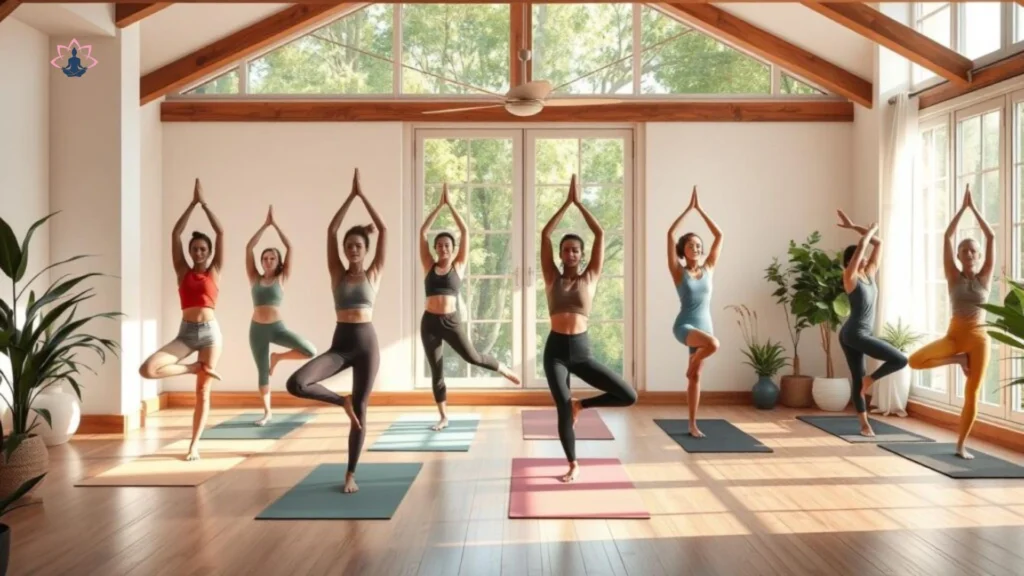
Yoga asanas are more than just physical movements. They connect body, mind, and spirit through special postures. These postures help improve overall wellness. Whether you’re new or experienced, learning yoga poses can bring great physical and mental benefits.
Our guide provides detailed insights into yoga poses, with photos and clear instructions. We aim to make complex movements easy to understand. This helps ensure safe and effective practice.
Exploring yoga asanas, you’ll learn key techniques and proper alignment. You’ll also gain confidence in your yoga journey. Each pose has its own story of strength, flexibility, and balance.
People all over India and the world use yoga for health. By mastering these poses, you can boost your fitness, lower stress, and grow self-awareness.
Understanding the Foundations of Yoga Asanas
Yoga is an ancient practice from Indian spiritual and physical culture. It has a long history, changing from spiritual meditation to a global wellness trend.
The history of yoga shows a deep connection between mind, body, and spirit. It started in the Indus Valley Civilization, with evidence from 3000 BCE.
Origins and Evolution of Yoga Poses
Yoga asanas have gone through many changes:
- Vedic Period: Spiritual meditation practices
- Classical Period: Systematization of physical postures
- Modern Era: Global adaptation and scientific validation
“Yoga is the journey of the self, through the self, to the self.” – The Bhagavad Gita
Benefits of Regular Asana Practice
Yoga offers more than just physical benefits. Regular practice improves overall wellness:
- Enhanced flexibility and strength
- Stress reduction and mental clarity
- Improved respiratory and cardiovascular health
- Boosted immune system functioning
Basic Principles of Alignment in Yoga
Alignment is key for safe and effective yoga practice. Important principles include:
- Maintaining proper body positioning
- Engaging core muscles
- Breathing synchronization
- Respecting individual body limitations
Understanding these foundational elements transforms yoga from mere exercise to a complete lifestyle practice.
Essential Equipment and Space Requirements for Yoga Practice
Getting ready for yoga is more than just wanting to try it. You need the right gear and a special place to practice. Finding the best yoga mat and props is key for everyone, from newbies to pros.
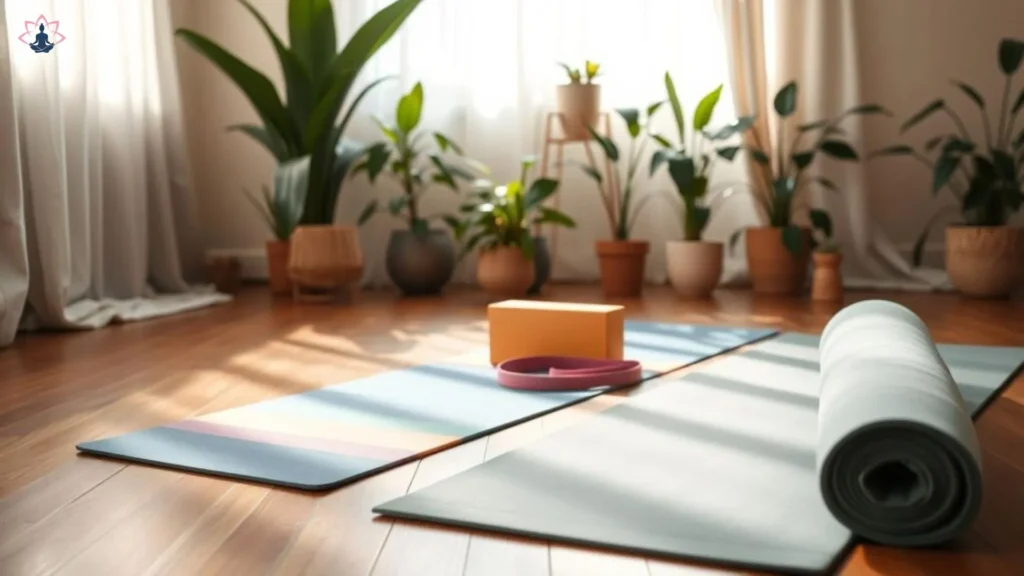
Choosing the right yoga mat is the first step. Quality is important. Think about these things:
- Thickness for joint protection
- Material durability
- Grip and texture
- Eco-friendliness
“A great yoga mat is like a trusted companion on your wellness journey.” – Yoga Master
Yoga props are also vital. They help everyone, no matter their skill level. They make poses easier and safer.
| Yoga Prop | Purpose | Recommended for |
|---|---|---|
| Yoga Blocks | Provide support and extension | Beginners, flexibility work |
| Yoga Straps | Assist in stretching | Limited flexibility, deep stretches |
| Bolsters | Support restorative poses | Relaxation, meditation |
Setting up a yoga space at home is more than just buying gear. Think about these things to make your space perfect:
- Natural lighting
- Minimal distractions
- Comfortable temperature
- Clean, clutter-free area
Good yoga gear and a well-thought-out space make your practice better. It makes each session more fun and helpful.
Beginner-Friendly Yoga Asanas with Pictures and Names
Starting yoga can seem scary for beginners. Learning the basics helps build confidence and lays a solid foundation for your journey. This guide covers essential poses that boost strength, flexibility, and body awareness.
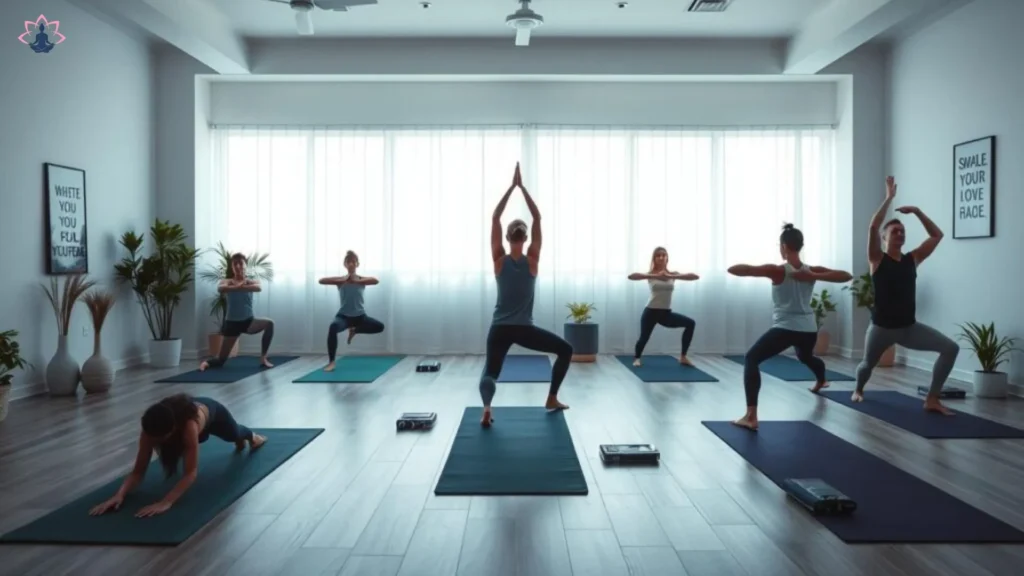
Yoga has poses for all skill levels. Beginners should start with standing, seated, and balancing poses. These poses introduce core movements and alignment.
Standing Poses for Beginners
Standing yoga poses are great for building strength and improving posture. They help beginners develop stability and learn how to align their body.
- Mountain Pose (Tadasana): Establishes basic standing alignment
- Tree Pose (Vrksasana): Introduces balance and concentration
- Warrior I (Virabhadrasana I): Builds leg strength and core engagement
Seated Poses for New Practitioners
Seated yoga poses are perfect for stretching and opening the body. They also help develop mindfulness and breath awareness.
- Easy Pose (Sukhasana): Fundamental meditation posture
- Seated Forward Bend (Paschimottanasana): Increases flexibility
- Butterfly Pose (Baddha Konasana): Opens hip muscles
Simple Balancing Poses
Balancing yoga poses challenge you to focus, build core strength, and control your body. They help improve stability and mental focus.
- Half Moon Pose (Ardha Chandrasana): Develops coordination
- Standing Split: Improves leg strength
- Eagle Pose (Garudasana): Enhances overall balance
“Yoga is not about touching your toes, it’s about what you learn on the way down.” – Jigar Gor
Always listen to your body, breathe deeply, and practice patiently. Each pose is a journey of self-discovery and growth.
Intermediate Level Asanas for Advanced Practice
Getting better at yoga takes hard work and moving up through more complex poses. Those who have learned the basics can now try harder poses. These poses need more strength, flexibility, and focus.
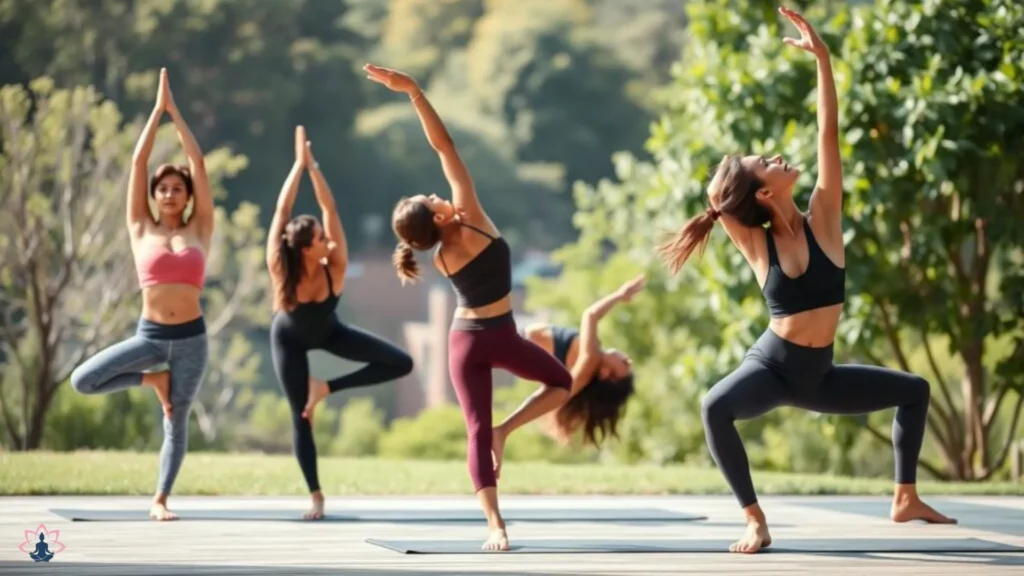
Starting intermediate yoga means knowing your limits. These poses help you connect your mind and body better. They also make your core stronger and your body more stable.
- Crow Pose (Bakasana): Develops arm and core strength
- King Pigeon Pose (Eka Pada Rajakapotasana): Enhances hip flexibility
- Scorpion Pose (Vrschikasana): Tests balance and back mobility
- Firefly Pose (Tittibhasana): Builds upper body and arm power
Each pose needs careful preparation and regular practice. Practitioners should approach these advanced asanas with patience and mindfulness. They should use the right alignment and might need props for support.
“Advanced yoga is not about perfection, but about progression and self-understanding.” – B.K.S. Iyengar
| Intermediate Pose | Primary Muscle Groups | Difficulty Level |
|---|---|---|
| Crow Pose | Arms, Core, Shoulders | Intermediate |
| King Pigeon Pose | Hips, Back, Quadriceps | Advanced |
| Scorpion Pose | Back, Core, Shoulders | Expert |
Adding intermediate poses to your routine needs slow skill growth. Always listen to your body and work with good teachers. Move forward at a pace that feels right to avoid injuries.
Proper Breathing Techniques During Asana Practice
Breathing is key in yoga. It turns a simple exercise into a meditative experience. Learning to breathe right can really improve your yoga.
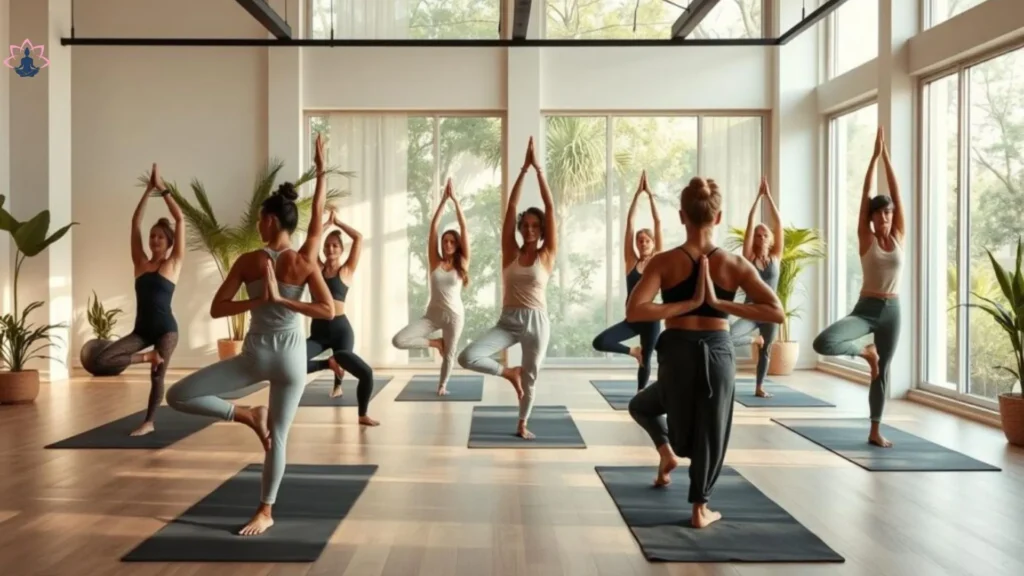
Breath links mind and body, making yoga powerful. People learn special breathing techniques. These techniques help with movement and focus.
Understanding Ujjayi Breath
Ujjayi breath, or ocean breath, is a basic yoga technique. It involves a slight throat constriction. This makes a soft sound when you breathe in and out.
- Creates internal heat in the body
- Improves concentration
- Regulates oxygen flow
- Supports smooth breath and movement in yoga
Synchronizing Breath with Movement
Breath and movement in yoga are closely tied. Each pose gets stronger with the right breathing.
| Pose Type | Breathing Pattern | Benefits |
|---|---|---|
| Standing Poses | Steady, deep Ujjayi breath | Builds strength and stability |
| Flowing Sequences | Rhythmic inhale/exhale | Increases flexibility and flow |
| Restorative Poses | Slow, relaxed breathing | Promotes relaxation |
Common Breathing Mistakes to Avoid
Many struggle with breathing in yoga. Shallow breathing or holding breath can mess up your practice.
“Breath is the bridge between body and mind.” – Yoga Philosophy
- Avoid tensing shoulders during breath
- Maintain consistent breath rhythm
- Practice diaphragmatic breathing
- Stay relaxed during challenging poses
Creating a Balanced Yoga Sequence
Making a balanced yoga practice needs careful planning. It’s about knowing how poses work together in a sequence. A good yoga flow can change how you feel physically and mentally. It helps you find balance between strength, flexibility, and being present.
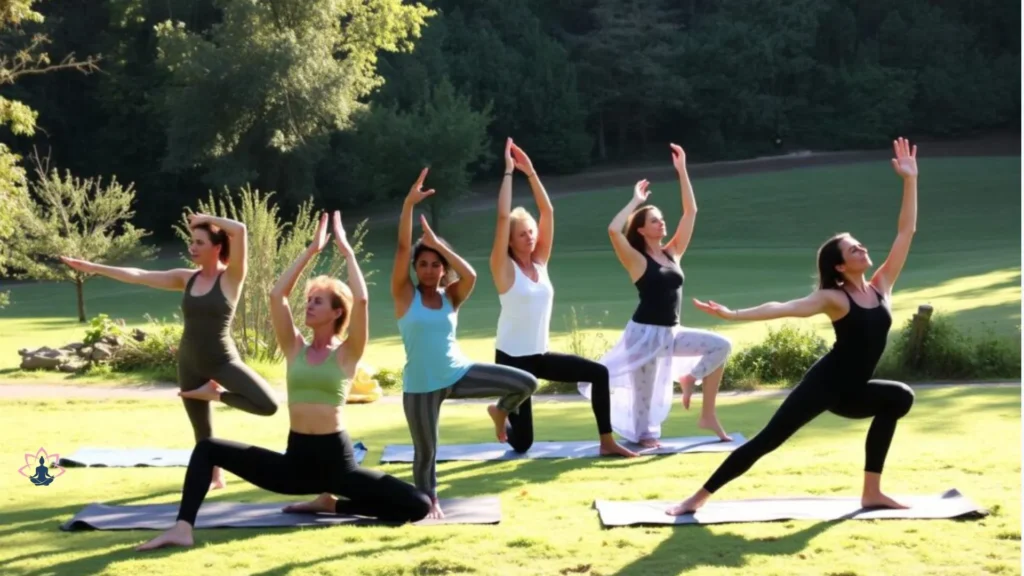
- Start with gentle warm-up poses to prepare the body
- Progress through increasing intensity of movements
- Include peak poses that challenge your practice
- End with restorative and cooling poses
“The art of yoga is not just in individual poses, but in how they connect and flow together.” – Yoga Master
A balanced yoga practice should have different pose types for full body engagement. This means mixing:
- Standing poses for stability
- Seated poses for flexibility
- Twists for spinal mobility
- Backbends for heart opening
- Inversions for perspective shift
To make a great yoga sequence, know what your body needs. Create a practice that’s both challenging and caring. Listen to your body and adjust poses as needed. This keeps your yoga flow safe and enjoyable.
Safety Guidelines and Common Modifications
Yoga is great for everyone, but it’s important to know how to stay safe. Every body is different, so we need to make yoga fit us perfectly. This way, we can enjoy it without worrying about getting hurt.
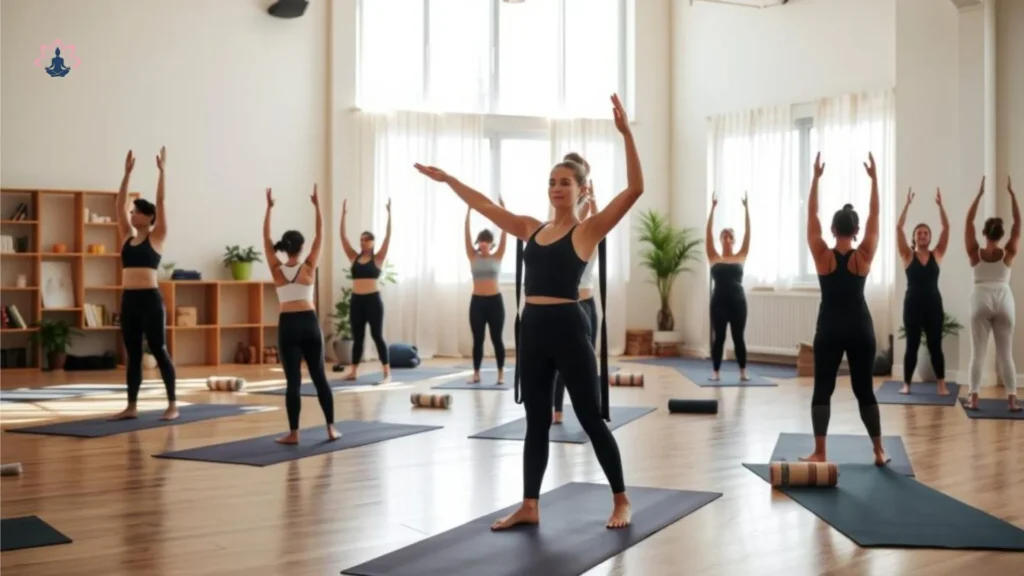
Being mindful in yoga means listening to your body. It’s okay to make changes to make it work for you. These changes are not a weakness, but a smart way to take care of yourself.
Adapting Poses for Different Body Types
Yoga props can really help if you have different abilities. They offer support for those who need it, whether it’s because of tight muscles or physical conditions. Here’s how they can help:
- Blocks help extend reach in standing poses
- Straps assist with stretching tight muscles
- Bolsters provide cushioning for restorative poses
Preventing Yoga-Related Injuries
“Your body is your greatest teacher. Listen carefully.” – Unknown Yoga Master
To avoid injuries, it’s important to know how to align your body right. Using yoga modifications wisely is key. Here are some tips:
- Warm up properly before challenging poses
- Avoid pushing beyond comfortable limits
- Maintain proper breathing techniques
When to Use Props and Supports
Yoga props are not just for beginners. Advanced practitioners can also benefit from them. Use supports when:
- Experiencing muscle tightness
- Recovering from injuries
- Wanting deeper, more supported stretches
Yoga is a journey of self-discovery and healing. Always put safety first, be open to making changes, and use props to improve your practice.
Conclusion
Yoga is more than just exercise. It’s a journey to better health and wellness. Each pose and breath helps you understand your body and mind better. This leads to self-discovery and balance.
Your yoga path is special and yours alone. By following this guide, remember that it’s the effort that counts, not being perfect. Slowly, you’ll become more flexible, clear-minded, and emotionally strong through yoga.
This guide covers yoga poses, breathing, and safety. It’s great for everyone, whether you’re new or have been practicing for a while. Always be patient, curious, and kind to your body.
Yoga is more than just moving your body. It’s a way to improve your physical health, calm your mind, and grow spiritually. See each moment on the mat as a chance to learn and grow.
FAQ
What are yoga asanas?
Yoga asanas are physical poses that help improve strength, flexibility, and balance. They are key in traditional yoga, aiming to align and calm the body, mind, and spirit.
How often should I practice yoga?
Practice yoga 3-5 times a week for the best results. Beginners can start with 2-3 times a week and increase as they get more comfortable. Being consistent helps build strength and flexibility.
Do I need special equipment to start yoga?
A yoga mat is recommended for comfort and safety. You can also use props like blocks, straps, and blankets, but they’re not necessary to start.
Can beginners do yoga?
Yes, yoga is for everyone, regardless of fitness level or age. Many classes offer beginner-friendly sequences to help new practitioners safely build strength and flexibility.
What are the main benefits of practicing yoga?
Yoga improves flexibility, strength, and reduces stress. It also enhances mental clarity, breathing, posture, and can help with chronic pain and anxiety.
How long does a typical yoga session last?
Sessions can last from 30 to 90 minutes. Beginners might start with 30-minute sessions, while more experienced practitioners might prefer longer classes.
What should I wear to a yoga class?
Wear comfortable, stretchy clothes that allow free movement. Choose moisture-wicking fabrics. Avoid loose clothes that might get in the way and opt for form-fitting but comfortable attire.
Is yoga a good workout?
Yes, yoga can be a great workout. Styles like Vinyasa or Power Yoga offer strength training, cardiovascular benefits, and improve fitness and flexibility.
Can yoga help with stress and anxiety?
Yes, yoga is excellent for managing stress and anxiety. It combines physical movement, controlled breathing, and meditation to calm the nervous system and reduce stress hormones.
How do I choose the right yoga style for me?
Think about your fitness level, goals, and preferences. Hatha is good for beginners, Vinyasa for more movement, Yin for stretching, and Ashtanga for a challenging practice. Try different styles to find what works best for you.